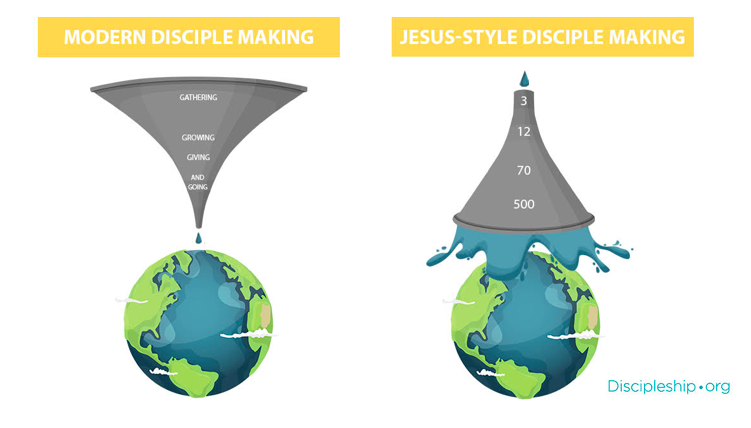When we align our methods to our message, we create an atmosphere that more readily facilitates what God desires in all of our lives. This is about making room for God’s Kingdom to come. Conversation extends beyond the words we say. We must be careful not to inadvertently say things we don’t mean to say. Our culture defines what we believe to be normal behavior and this is defined by what’s emphasized, communicated and celebrated.
If your stage time and print space is always full of events, then you’re (subconsciously) saying that a healthy disciple is one that attends lots of events. If you always find yourself promoting different classes and studies, then you’re (subconsciously) saying that a healthy disciple is one that studies.
All of these things can be helpful in the pathway of discipleship, but do they lead to maturity? How can we determine if they lead to maturity? As helpful as these things can be when we make discipleship all about attending events, classes and studies, we’re actually subtly celebrating and promoting a consumeristic approach to faith. The Law does not produce life, so this is not about institutionalizing our efforts. Rather this is about organizing the organism of the church in such a way that it perpetuates a mature approach to the pursuit of God’s presence in personal places of prayer and self-feeding on the Word as a central goal to making disciples. Jesus initiated a disciple making movement that produced disciples that would multiply disciples. Today we are more a church service movement gathering around a pulpit rather than mobilizing people to experience and enjoy God’s presence in their daily lives. This, by default, emphasizes weekend sermons rather than disciple making movements.
We are not to forsake the assembling of ourselves together (Hebrews 10:25). However, in the gathering we can center more around the presence rather than the pulpit communicating the pursuit of God as a way of life.
In his book, No Silver Bullets, author Daniel IM describes approaches that churches typically take in their discipleship process and challenges the reader to think through small changes that produce lasting results. IM defines a silver bullet as follows: “one-decision solutions that will solve all your woes and unleash your church into a new season of faithfulness” Im suggests “micro-shifts” in how we do ministry. The micro-shifts Im suggests are focused around what we understand discipleship to be and how we do it. They involve small shifts that will take you:
- FROM DESTINATION TO DIRECTION
- FROM OUTPUT TO INPUT
- FROM SAGE TO GUIDE
- FROM FORM TO FUNCTION
- FROM MATURITY TO MISSIONARY
DESTINATION TO DIRECTION
The first shift deals with how we understand discipleship. A destination approach thinks of discipleship in terms of the general direction the “disciple” is moving instead of an end destination to be reached
OUTPUT TO INPUT
The second shift pertains to what an individual needs to do to move in the direction of following Jesus. Churches often want disciples to demonstrate knowledge of the bible, fruit of the Spirit, gifts of the Spirit, etc. These are output goals or results. Input goals are those practices that make output goals achievable. Based on Lifeway Research, Im argues that reading the Bible, attending Sunday worship, and participating in smaller groups are three inputs that greatly influence output results.
SAGE TO GUIDE
The third shift addresses the role of the leader in this process. Pastors often feel that they need to be the “sage on the stage,” the person with answers to all discipleship questions. Drawing on adult learning studies, Im advises pastors and church leaders to adopt an approach referred to as being a “guide on the side.” In this approach, the teacher puts the learner in the driving seat, helping them when they get stuck.
FORM TO FUNCTION
In the fourth shift, Im talks about moving from form to function. This is an especially good chapter for churches that are still debating whether Sunday school ,small groups or missional communities are a better discipleship methodology. Im argues that the function of discipling is more important than the form in which it takes places. Having said that, he proposes mid-size communities in the church as a particularly fruitful venue for discipleship.
MATURITY TO MISSIONARY
Finally, Im focuses on the purpose of discipleship. Most churches understand discipleship in terms of spiritual maturity, but Im thinks they ought to understand it in terms of being a missionary.

